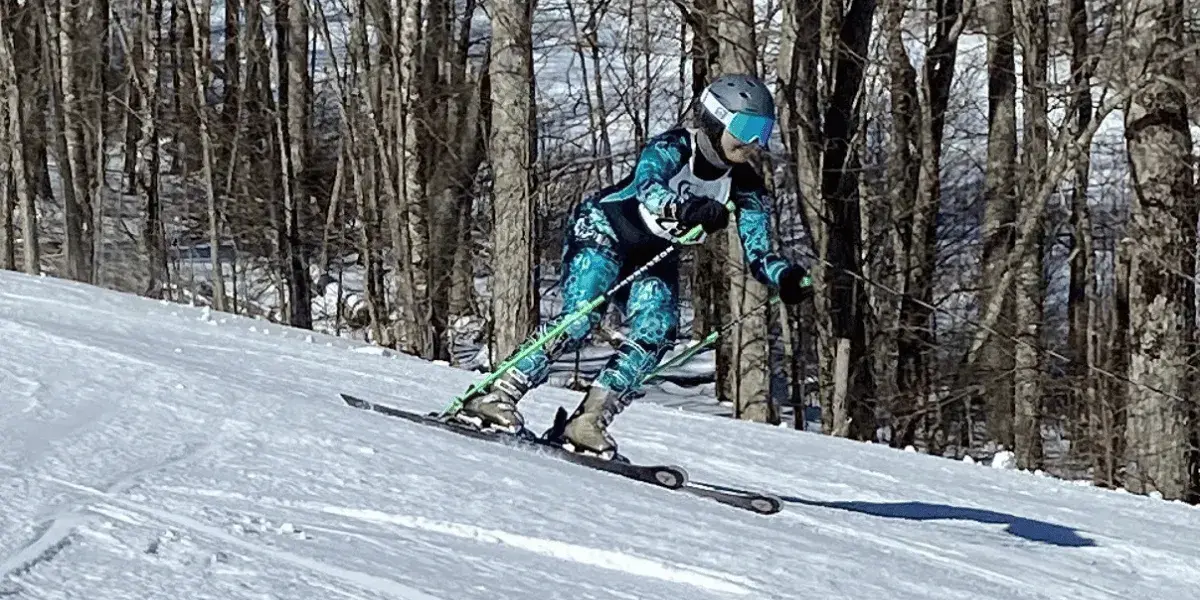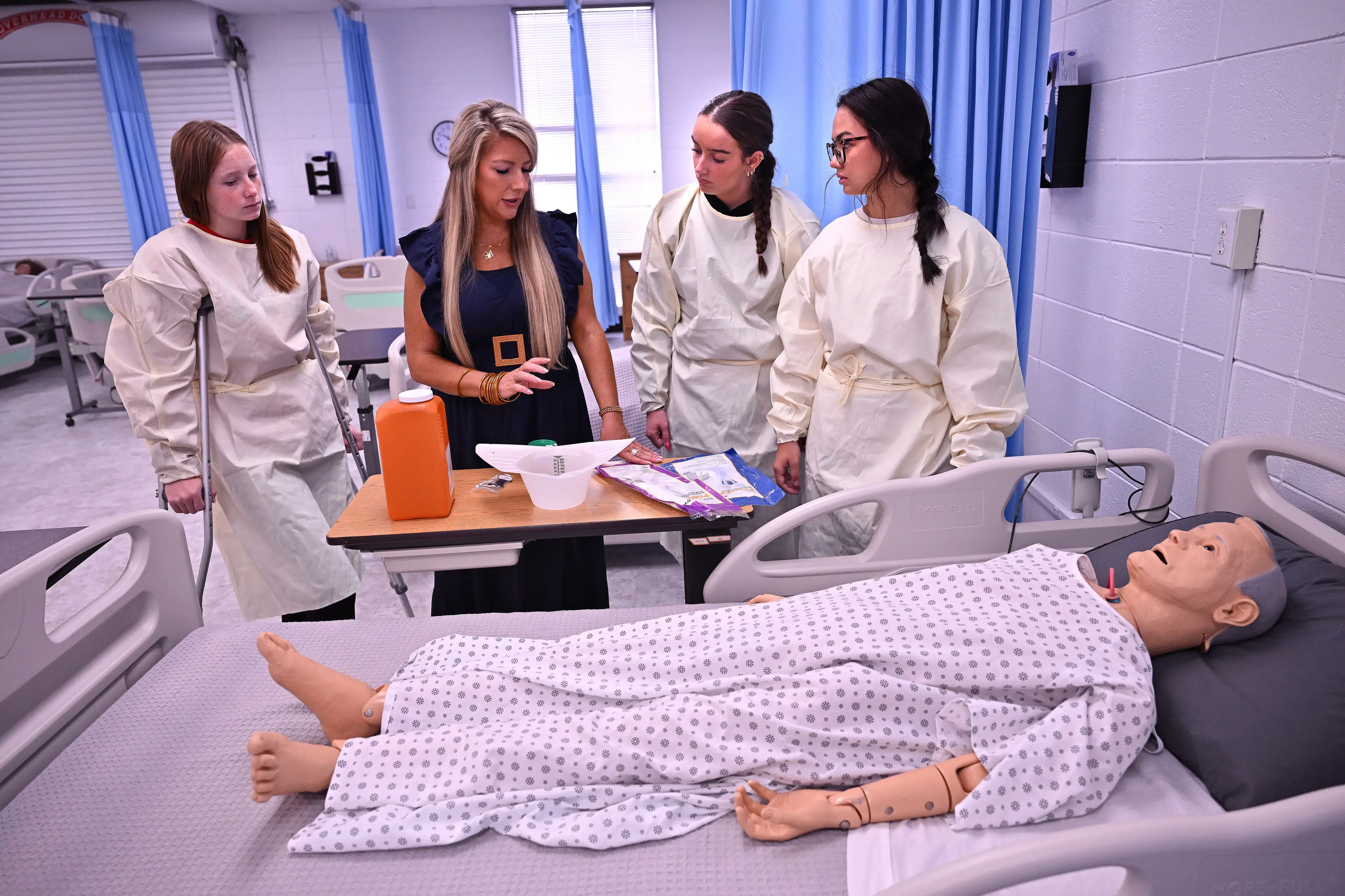
Andrea's Story: Why a physical therapist chose the BEAR® Implant to return to snow ski racing
Andrea Pendley is a snow ski racer and a physical therapist for Bon Secours Piedmont Orthopaedics in Greenville, South Carolina.
Andrea first tore her anterior cruciate ligament (ACL) in high school gymnastics and underwent ACL reconstruction (ACLR) with a hamstring tendon graft. In Winter 2023, she tore the ACL in the opposite knee, which is called a contralateral tear.
Although she first heard about the BEAR® Implant during physical therapy school, it came up again when she was researching options beyond traditional ACL surgery for her second ACL tear.
Andrea decided to get the BEAR Implant this time and sought out Dr. Gregory Colbath, an orthopaedic surgeon at Spartanburg Regional Healthcare System in Spartanburg, South Carolina.
We spoke with Andrea and Dr. Colbath about why the BEAR Implant was the right option for her, how her perspective as a physical therapist helped to shape her recovery and her return to snow ski racing.
Q: Can you tell us about your second ACL tear?
Andrea: I was training for a snow ski race and while skiing slalom gates, my ski caught an edge, my bindings didn’t release, and I ended up crashing. I felt a pop when I fell, and my knee kept giving out as I tried to get up to ski again. I knew both my knees have ligamentous laxity, and I opted for more conservative treatment by doing rehab on myself before going to see the orthopaedic surgeon. However, a month later my knee still felt a little unstable, so I decided to get an MRI, which confirmed my ACL tear.
Q: How did you learn about the BEAR Implant and why was it the right option for you?
Andrea: I first learned about the BEAR Implant at physical therapy school in 2018, but I’d only had patients undergo patellar tendon ACLR in professional practice. Although I didn’t have a bad experience with the hamstring tendon graft before, residual weakness in my hamstring and lingering issues from a damaged meniscus in that same knee had led to flare ups of anterior pain.
Although getting another hamstring tendon graft was an option, it wasn’t ideal because the stability of my knee is important for snow ski racing. As I dug into deciding what kind of surgery I wanted this time, I found the BEAR Implant two-year study results. The research indicated that it would be less invasive compared to ACLR and could potentially result in less pain and less swelling post-surgery. A friend of a friend then introduced me to Dr. Colbath, who confirmed I would be a great candidate.
Q: What, in your opinion, is most notable about the BEAR Implant? How has it impacted how you treat ACL tears?
Dr. Colbath: The BEAR Implant allows the surgeon to utilize the patient’s native ACL to preserve and repair using a biologic scaffold. It provides me with another option in our treatment algorithm, particularly with ACL tears that are amenable to repair, giving us a more thoughtful approach for surgery tailored to the patient’s specific needs, demands, and desires.
Q: As a physical therapist, why did you select the BEAR Implant?
Andrea: As a physical therapist, I have treated many patients with patellar tendon grafts, so I know the typical trajectory of rehab. I really liked that while the BEAR Implant rehab has a different protocol with slower initial rehab, it didn’t have inferior results to gold standard reconstruction. I find the BEAR Implant very interesting because it allows you to connect the two torn ends of your ACL to let it grow back together versus using a graft. It was really exciting to listen to Dr. Colbath describe the procedure and the science behind it.
Q: Why was Andrea a good candidate for the BEAR Implant? What unique considerations are there for athletes like Andrea when it comes to the BEAR Implant vs. ACLR?
Dr. Colbath: Andrea was the ideal candidate because she was motivated and informed. Her injury was also the ideal tear pattern to consider an option like the BEAR Implant. As a physical therapist who had already undergone an ACL reconstruction on her opposite leg, she knew the time and investment that would be required for the road to recovery.
Having done her own research, she also knew that there were alternative options such as the BEAR Implant that may have been more ideal for her situation and demands. As a competitive skier, she wanted a procedure that would provide her with strength and confidence without sacrificing her potential return to full performance, which can often occur with other ACL graft options.
Q: Why is the BEAR a good option for an athlete like Andrea who experienced contralateral tears? Is there anything that can be done to reduce the risk of retears in the future?
Dr. Colbath: Andrea’s prior ACL reconstruction on her contralateral leg certainly informed her decision-making process. She desired options to autografts that would not compromise her quad or hamstring functions. Not all ACL tears are amenable to repair options, and surgeons and patients must understand that there are limitations to this technology. There is always a risk for retear for any patient such as Andrea who is returning to competitive and demanding sports. However, by not having to harvest your own tendons, or “robbing Peter to pay Paul,” the BEAR Implant has the potential to provide us with a more natural repair and recovery.
Q. Tell us about rehab.
Andrea: Rehab for the BEAR Implant went really smoothly but had some differences to my ACLR rehab with the opposite knee a decade ago. With the BEAR Implant, I was 50% weight bearing for the first four weeks, which is a concern for preventing muscle atrophy. My knowledge about what my body, tissue healing timelines and sport-specific physical requirements allowed me to better tailor my progression. My coworker helped assist while I treated myself with the protocol. I went back to work at 12 weeks post-surgery, and I gradually progressed to do more cutting, pivoting and running in line with the protocol.
Dr. Colbath: Andrea’s post-operative recovery was remarkable and informative for me as a surgeon, especially since she kept me posted with a personal diary each month of her progression. She noted and thoroughly documented improved pain, quicker recovery, and improved strength in her BEAR Implant leg at every time point during her postoperative recovery.
Andrea brought a unique perspective as both a patient and a physical therapist provider during her recovery, especially since she also had the prior experience of completing rehab for the prior ACL reconstruction on her opposite knee. I’m not sure if there’s another patient who has undergone the BEAR Implant who is better suited to help surgeons, physical therapists and patients understand the unique benefits of the BEAR Implant in our treatment algorithm.
Q: Can you tell us about returning to skiing and snow ski racing?
Andrea: I returned to free skiing 11 months after surgery, and I returned to snow ski racing at the one-year mark. My first day back, I went skiing with my mom, and we took it easy while I got my ski legs back. I was a little nervous at first, but eventually I progressed with narrowing turn radius, increasing speed, and getting ready for racing.
At the one-year mark, I did my first snow ski race since my injury. I took things slowly, starting with wider giant slalom gates and starting practice with slalom gates as they put more demand on the knee. After the race was over, I felt confident that I could continue to progress toward skiing full force. Since then, I’ve continued to race for fun, and I’m happy to say I’m keeping up with everyone. Most recently, we had a race at the end of the Winter 2025 season, and I was the third fastest female for giant slalom and fourth fastest overall out of approximately 90 racers.
Q: How does your BEAR Implant knee feel today?
Andrea: My BEAR Implant knee feels completely normal. My range of motion was back to normal by my 12-week follow-up visit, followed by strength coming along at the six-month mark along with 90% of limb symmetry. Although I still ski with a knee brace on for caution due to skiing being a heavy cutting and heavy pivoting sport, I’m very confident in my knee. There’s nothing I’m afraid to do, I’m just more aware of doing things safely to avoid retearing my ACL.
Q: Do you have any advice for patients who are considering the BEAR Implant?
Andrea: First and foremost, listen to your care team – your surgeon, your physical therapist and yourself. There is reason and purpose behind what they tell you. Prehab is crucial for your success because building up your strength can lead to better outcomes. Post-surgery propping your leg up with a wedge pillow versus flat pillows can be really helpful to combat lack of extension and leg motion. Rehab is no joke, and it’s important to take it seriously. Don’t be afraid to speak up when you face issues such as swelling or your brace being too tight so that your care team can help make adjustments. And remember that your tissues need time to heal!
Q: How has getting the BEAR Implant changed your life and what are your plans for the future?
Andrea: From a professional aspect, getting this BEAR Implant has been really interesting in my role as a physical therapist because it allows me to have a more connected patient rapport. I get what they’re going through, and I have the experience of recovering from both ACLR and the BEAR Implant. When it comes to snow ski racing, I love my ski community, and I plan on doing this as long as I can. My mom still snow ski races at 60 years old, and I would love to be able to continue to race even into my 80s!












